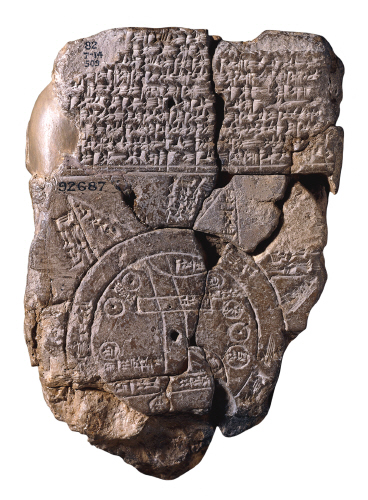The earliest known world maps date to classical antiquity, the oldest examples of the 6th to 5th centuries BC still based on the flat Earth paradigm. World maps assuming a spherical Earth first appear in the Hellenistic period. The developments of Greek geography during this time, notably by Eratosthenes and Posidonius culminated in the Roman era, with Ptolemy’s world map (2nd century AD), which would remain authoritative throughout the Middle Ages.
Since Ptolemy, knowledge of the approximate size of the globe allowed cartographers to estimate the extent of their geographical knowledge, and to indicate parts of the globe known to exist but not yet explored as terra incognita. With the Age of Discovery, during the 15th to 18th centuries, world maps became increasingly accurate; exploration of Antarctica and the interior of Africa was left to the 19th and early 20th century.
A Babylonian world map, known as the Imago Mundi, is commonly dated to the 6th century BCE, and is considered to be the oldest map in the world.

The Babylonian Map of the World is a diagrammatic labeled depiction of the known world from the perspective of Babylonia. The map is incised on a clay tablet, showing Babylon somewhat to the north of its center; the clay tablet is damaged, and also contains a section of cuneiform text.It is usually dated to the 5th century BC.It was discovered at Sippar, southern Iraq, 60 miles (97 km) north of Babylon on the east bank of the Euphrates River, and published in 1899.The clay tablet resides at theBritish Museum (BM 92687).

It is conjectured that the island locations, though possibly referring to real areas, may also represent a mythological interpretation of the world.Carlo Zaccagnini has argued that the Babylonian map of the world may have lived on in the T and O map of the European Middle Ages.The map is circular with two outer defined circles. Cuneiform script labels all locations inside the circular map, as well as a few regions outside. The two outer circles represent water in between and is labelled as “‘river’ of ‘bitter’ water”, the salt sea.Babylon is in the center of the map; parallel lines at the bottom seem to represent the southern marshes, and a curved line coming from the north, northeast appear to represent the Zagros Mountains.There are seven small interior circles at the perimeter areas within the circle, and they appear to represent seven cities.Seven triangular sections on the external circle (water perimeter) represent named islands, but the damaged clay tablet has lost the three islands on the tablet’s lower edge.
The three islands are named :island-“place of the rising sun”, island-“the sun is hidden and nothing can be seen, island-“beyond the flight of birds.